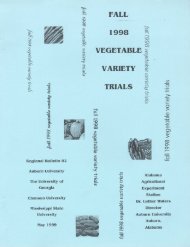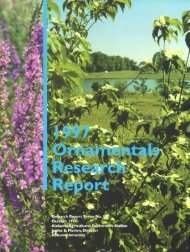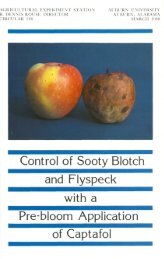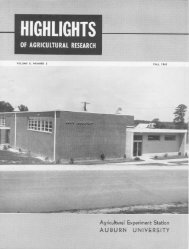MARKETING CHRISTMAS TREES - Auburn University Repository
MARKETING CHRISTMAS TREES - Auburn University Repository
MARKETING CHRISTMAS TREES - Auburn University Repository
Create successful ePaper yourself
Turn your PDF publications into a flip-book with our unique Google optimized e-Paper software.
10 ALABAMA<br />
AGRICULTURAL EXPERIMENT STATION<br />
20 days before Christmas. They did know that the trees had been<br />
cut and bundled for shipment from 1 to 3 months earlier.<br />
Upon receipt of shipments, lots of trees were prominently displayed.<br />
Reserve supplies were usually stored where convenient<br />
more as a safeguard against pilferers than as a maintenance of<br />
quality. The trees were displayed prominently with relatively<br />
little concern for shading or other protection, especially if it were<br />
inconvenient to provide such protection. Occasionally, the selling<br />
location lent itself to putting the tree stems into dug holes<br />
where the earth might supply some moisture. However, the purpose<br />
of this practice was to display trees to the customers rather<br />
than to lengthen tree life. More protection might well have lessened<br />
needle drop in many instances.<br />
Treatment of locally grown and short haul imported trees was<br />
essentially the same as for the bulk of imported natural-color<br />
trees. Even with this treatment, complaints about needle drop<br />
for locally grown trees were negligible.<br />
The small ornamentals were usually suited to display in buildings,<br />
and were displayed on shelves by chain stores, which sold<br />
the bulk of these trees. They apparently stood this treatment<br />
quite well; no complaints were recorded.<br />
Tinted Trees<br />
Treatment of trees for ornamentation appears to be growing in<br />
recent years. However, established retailers reported that the<br />
use of tinted trees, at least on a modest scale, has been a custom<br />
of some people for a number of years. Nevertheless, ornamentals<br />
(normally treated, tinted, sealed at the base in metal stands, and<br />
cartoned for shipping) were not sold in many Alabama cities until<br />
TABLE 4. PERCENTAGE OF <strong>CHRISTMAS</strong> <strong>TREES</strong> THAT WERE TINTED, BY SPECIES AND<br />
BY SIZE OF TREE, 11 SELECTED MARKETS, ALABAMA, 1956<br />
Size of tree'<br />
Species Very All<br />
Speies Small Medium Large large sizes<br />
Pct. Pct. Pct. Pct. Pct.<br />
_<br />
Spruce and fir2<br />
80.6 14.6 1.5 0.0 19.7<br />
Cedar and pine' 18.0 18.1 8.4 .0 18.1<br />
Arizona cypress' .0 12.7 12.8 .0 11.2<br />
All species .................... 27.6 13.9 4.8 0.0 17.3<br />
1 For description of usual heights of respective size groups, see Table 1.<br />
2 Largely imported varieties from northern states or from Canada.<br />
SLargely state-grown varieties or shipped in from southern Tennessee.
















